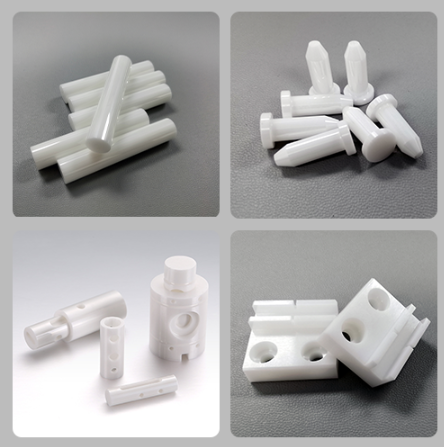Ceramic Materials
Ceramic Materials Overview
Technical ceramic materials have the ability to make products lighter, more efficient, longer lasting, reduce maintenance intervals, and reduce operating costs. They are frequently being used to replace metals, polymers, and refractory materials in a wide variety of applications due to their notable high temperature capability, hardness, and electrical properties.
Precision Ceramics offers a wide range of advanced technical ceramic materials to ensure that we have the right material for your application.

Alumina ceramic
Alumina ceramic is the most common advanced ceramic material and a relatively traditional material. High-purity alumina ceramics, as an excellent ceramic material, have been widely used in many industries. The material has excellent electrical insulation, high thermal conductivity, high chemical resistance, good wear resistance and low thermal expansion. Alumina ceramics are divided into several application grades based on their alumina content. 99% alumina ceramic materials are used to manufacture high-temperature crucibles, refractory furnace tubes, ceramic bearings, ceramic seals, water valves and other special wear-resistant materials; 95%-96% alumina ceramics are mainly used for corrosion-resistant and wear-resistant components and circuits substrate. Herun Ceramics can provide many different types of alumina, including: injection molding, compression molding, isostatic molding, slip molding and extrusion molding.

Zirconia ceramic
Zirconia generally refers to zirconium dioxide, with the chemical formula ZrO2. It is the main oxide of zirconium. It is usually a white, odorless and tasteless crystal, and is insoluble in water, hydrochloric acid and dilute sulfuric acid. Unlike traditional ceramics, which tend to become hard and brittle, zirconia has high strength, wear resistance and flexibility that far exceeds that of most other technical ceramics. Zirconia is a very strong industrial ceramic with excellent properties in terms of hardness, fracture toughness and corrosion resistance. There are several grades of zirconia, the most common being yttria-partially stabilized zirconia (Y-PSZ) and magnesia-partially stabilized zirconia (Mg-PSZ). Its unique resistance to crack growth and high thermal expansion make it an excellent material for joining ceramics to metals like steel. Because of its unique properties, zirconia is sometimes called "ceramic steel."

Silicon nitride ceramics
silicon nitride ceramics Silicon nitride (Si3N4) is a high melting point ceramic material with extremely high hardness and chemical inertness. Hot-pressed silicon nitride, in particular, is one of the hardest substances in the world. Silicon nitride ceramics have a low thermal expansion coefficient and a high thermal conductivity, so they have excellent thermal shock resistance. At temperatures that are not too high, silicon nitride has high strength and impact resistance, but above 1200°C, it will be damaged over time, reducing its strength. Fatigue damage is more likely to occur above 1450°C. Therefore, the use temperature of silicon nitride generally does not exceed 1300°C. Because silicon nitride ceramics have such excellent properties, it is often used to manufacture mechanical components such as bearings, turbine blades, mechanical seal rings, and permanent molds.

Silicon carbide (SiC)
Silicon carbide (SiC), also known as emery. Ceramics made of silicon carbide not only have excellent room-temperature mechanical properties, such as high flexural strength, excellent oxidation resistance, good stain resistance, high fatigue resistance and low surface coefficient, but also high-temperature mechanical properties (strength , creep resistance, etc.) is the best among known ceramic materials. The molding methods of silicon carbide ceramics include hot pressure brazing, pressureless brazing, hot isostatic pressure brazing, etc. Its high-temperature strength can be maintained up to 1600°C, making it the material with the best high-temperature strength among ceramic materials. The biggest feature of silicon carbide ceramics is high high temperature strength. The strength of ordinary ceramic materials will be significantly reduced at 1200~1400℃, while the flexural strength of silicon carbide still maintains a corresponding level of 500~600MPa at 1400℃, so its working temperature Up to 1600 ~ 1700.

Aluminum nitride
Aluminum nitride ceramic is one of the advanced ceramic materials and is widely used in the electronics industry because of its excellent thermal conductivity and electrical insulation properties. Aluminum nitride crystal is a covalently bonded compound with [AIN4] tetrahedron as the structural unit. It has a wurtzite structure and belongs to the hexagonal crystal system. As a high-temperature-resistant material, its single-crystal thermal conductivity is almost five times that of alumina, and it has good thermal shock resistance and can be used in an inert atmosphere of 1350°C. Aluminum nitride is resistant to attack by molten metal and stable to acids. When its surface is exposed to moist air, it will react to form an extremely thin oxide film. Taking advantage of this characteristic, it can be used as a crucible and firing mold material for the smelting of aluminum, copper, silver, lead and other metals. AIN ceramics have better metallization properties and can replace toxic beryllium oxide ceramics and are widely used in the electronics industry.

Processable glass-ceramics
Processable glass-ceramics are fluorphlogopite glass-ceramics with synthetic mica as the main crystal phase. The main components are fluorphlogopite (Mg3K[AlF2O(SiO3)3]) and glass with silica as the main component. It is a new material that emerged in the 1970s. It has high mechanical strength, excellent dielectric properties and thermal properties, and good chemical stability. The most outstanding feature of processable ceramics is good processability. It can use general metal processing equipment for turning, milling, planing, sawing, grinding, cutting, tapping, etc. to process various parts with complex shapes, and can achieve very high processing accuracy. No special cutting tools or equipment are required.
